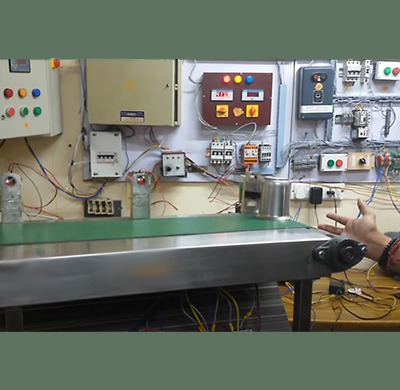The Head Scratching Problem
Recently a client sent us a complete conveyor system including the frame, belt, and power supply which they had extracted from their production facility the day before. The fault was reported as an error with the Variable Speed Drive (VSD) controller which would suddenly stop the conveyor motor frequently during each production run. The error on the VSD seemed erratic and each time inconsistent with the previous errors so our client could not diagnose the issue. For a company to deliver to us the entire machine and not just the faulty VSD for us to repair is strange so we knew that sending the entire conveyor belt system meant this one was going to be a couple of late nights thinking about this.
Like all machinery these days, the conveyor section plugs into the central production control system (CPCS) so it knows when to speed up and slow down in harmony with all the machines around it. Our first task was to set up a simple controller to simulate the CPCS and then wait to see if the VSD fails. Thank heavens for the simple little Arduino microprocessors and an ethernet shield.
After powering up the conveyor, it took just over an hour for the VSD to stop the motor. The error code reported an overtemperature issue. As the motor doesn’t have a temperature sensor, and the VSD was quite cool, we investigated and found an issue with the VSD thermistor. We also noticed a huge black stain on the power controller board around the high-power IGBTs (driving transistors). After we addressed the thermistor and IGBT issues, we ran the VSD through various tests which revealed an almost invisible hairline fault near the CPU. With over 14 years of experience with this type of drive, we knew we had found the reason for the erratic error codes. We then cleaned the black soot, replaced the two faulty IGBTs, re-checked the circuitry and then fully tested each function and feature. The VSD was found to be operating like brand new – YIPEE, SUCCESS.
Then unexpectedly the real fault-finding began, and it turned into a real head-scratching issue…
We re-installed the VSD into the conveyor and gave the whole system a complete re-test. After about three hours, we noticed the conveyor had stopped again. The drive reporting an over-current issue. Our immediate thought was IMPOSSIBLE!!!! The VSD was removed and taken through our entire testing regime a second time and it passed with flying colours. We re-installed the VSD on the conveyor and a few hours later the same fault. Why we asked?
After a lot more head-scratching and testing, we decided to trust our testing process and deem the VSD as faultless, so then we went about finding another cause. What we noticed was the motor was now erratically drawing an excessive amount of current. Strangely it wasn’t before we did the repair to the VSD? After removing the conveyor belt and spinning each roller by hand, we finally found the drive roller on the conveyor was sometimes ‘tight’. The bearings on each side looked ok so again we ask, why? Further investigation found that this roller had double bearings installed on each side and the inner bearing on one side fell apart. This could only have happened during our VSD final testing as the motor amps were ok when we originally tested before the VSD was repaired. It now appears that the broken pieces were intermittingly jamming inside the roller.
We were more than delighted when the roller was repaired, and everything worked properly. Our client was more than ecstatic as he thought he needed to buy a new VSD and to import the updated model (the current model was superseded many years ago) meant huge cost and modification to the existing system. Our client has now asked us to service three other VSDs that are considered critical for his business.
See on LinkedIn Here

